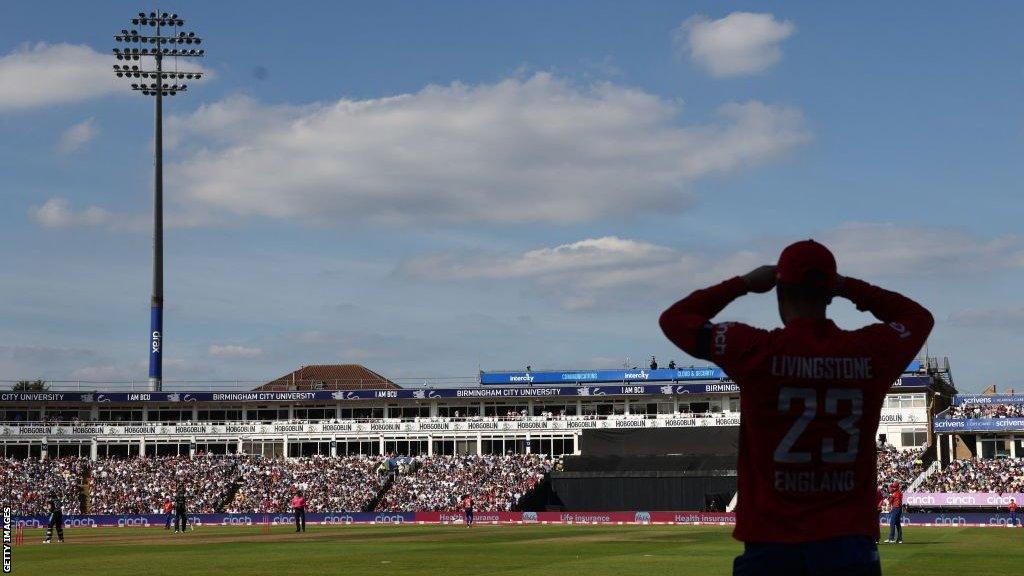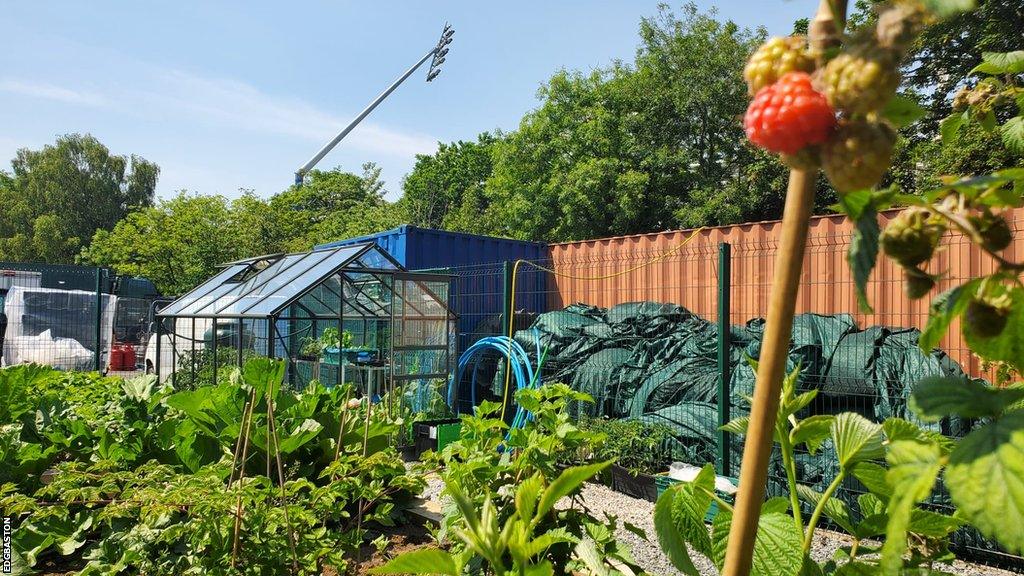England v New Zealand: Was Edgbaston's Go Green game a hint at cricket's future?
- Published

New Zealand beat England by 74 runs in the third T20
To the naked eye, Sunday's third T20 between England and New Zealand was just another afternoon of cricket - beer, sixes and the occasional chants from the famed Hollies Stand.
But for Edgbaston this was a step into what they see as cricket's future.
It was a day built on sustainability, the Go Green game, and the first of its kind in the UK.
On Sunday, the 25,000-seater stadium was run entirely off wind, hydro and solar power - something that will continue for the rest of September.
The four and six cards waved in the crowd at cricket matches for two decades or more were produced with 'seed paper' which, when planted at home, will grow wild flowers.
The lawnmowers and roller used to prepare the playing surface were switched to electric alternatives, while red meat was banned from the hospitality menus, although not from the burger vans around the ground.
Spectators' food was, however, wrapped in sustainable packaging lined with seaweed, whether they knew it or not.
The eruptions of fire, part of the travelling roadshow of T20 cricket rather than a host venue's choice, when Finn Allen hit the game's first six felt a strange elephant in the room.
"We want to be known for being a sustainable venue," Lydia Carrington, Edgbaston's first sustainability manager, told BBC Sport.
"We want people to think when they come here they are making a positive impact. Even if it is a big event, the impact they are having is a positive one."
What made this day unique is that every watt of electricity, every prawn sandwich made, will be calculated in a report which rates the day's carbon footprint.
A trial for T20 Finals Day at Edgbaston last year found 79% of emissions were caused by spectator and staff travel.
Free shuttle buses were put on this year as a result (and used if the long queues outside Birmingham New Street station on Sunday lunchtime were anything to go by) and car parks at the ground were closed.
"Why wouldn't we do it?" said Claire Daniel, Edgbaston's operations director. "We want cricket to be around for a really long time and have to make this change."
Climate change is one of cricket's uncomfortable truths.
Reports into its impact on sport, external have said cricket will be the hardest hit of all those that use a pitch or field.
Around 40% of cricket grounds in England and Wales, thousands in the recreational game, are at risk of the impacts of a changing climate, whether through drought or flooding.
And cricket is hardly an innocent party.
England's nearest opponents in the World Test Championship are Pakistan - an eight-hour flight away on a good day.

Edgbaston has an on-site allotment with produce used in the food at the ground
Gallons upon gallons of water go into making a cricket wicket.
It should be said, Edgbaston are not the only ones pushing for sustainability.
Lord's has been run entirely off wind power since 2017. The new Galadari stand at The Kia Oval is covered by solar panels.
Surrey, like Warwickshire, have committed to being Net Zero by 2030.
Gloucestershire are another county that leads the way, which begs the question: 'why can't every cricket match, at every venue, be a Go Green game?'
Edgbaston certainly want it to be the norm within two years.
"Someone has to be the first," said Dr Iain James, the England and Wales Cricket Board head of facilities services - part of the governing body's sustainability team.
"There is a footprint at cricket matches and Edgbaston are looking to address that. We need to see the learning before we can understand the rate we can all get there."
The ECB is expected to release a new plan for sustainability later this year.
It has given around £3m in funding to clubs across the country to help them be more sustainable, whether through changing to more efficient boilers in pavilions and clubhouses, installing solar panels or more modern machinery.
At the elite level, it wants to encourage other counties to follow the lead of Edgbaston with its eco-drive.
Perhaps slightly tongue in cheek, those at Warwickshire talk of a future of the Hollies roof being covered by solar panels - a stand that produces electricity as well as (reusable) beer snakes.
"I would like to move to solar power with self-generating on site and be self-sufficient," said Carrington.
What next? A wind turbine alongside Father Time at Lord's, or kinetic energy created by those walking to the top of Old Trafford's temporary stand?
Dr James, a university academic covering sustainability in sports stadia before joining the ECB, thinks changes could be more practical.
"The whole construction industry, not just the stadia, is looking at more sustainable materials," he said.
"That is very important. There is a lot of carbon in concrete.
"You will see more venues trying to use existing structures and adapting those rather than razing to the ground and building up again.
"Energy wise, on-site generation might be easier with solar panels than wind turbines in most of our city centre grounds.
"Recent developments at Lord's have included green walls that help with biodiversity and thermal management.
"We will see spectators taking responsibility, not because we say so, but because they will want look at how they travel to venues.
"We, at the ECB, will support people to make good sustainable choices."
Change is coming. Cricket probably needs it.
NZ's Allen hits Rashid for three sixes in a row